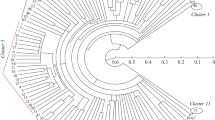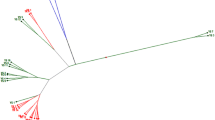Abstract
Thirteen varieties of Brazilian barley selected for malting qualities were analysed by RAPD (Random Amplified Polymorphic DNA). Amplification with 18 random primers generated 221 reproducible bands, of which 206 bands were polymorphic (93%):of this number, 137 fragments (62%) detected diversity among varieties and 56 bands (25.34%) allowed the distinction of varieties or groups of them. Variation was detected in all Brazilian varieties studied. Within-variety similarities estimated by Jaccard Similarity Coefficient ranged from 0.28 to 0.94, with averages ranging from 0.57 to 0.83, and an overall average of 0.72. Nevertheless, in the cluster analysis representatives of the same variety always fell into the same group and only later joined the other varieties. The average intervarietal similarities estimated by Jaccard Similarity Coefficient ranged from 0.45 to 0.62, with an overall average of 0.52. Many bands or combinations of bands which were responsible for the differentiation of all varieties were detected. Nevertheless, the majority of these bands cannot be considered as diagnostic markers because a great number of them did not occur in many representatives of the variety or had low intensity or even because they were not easily identified in the total pattern of bands.
Similar content being viewed by others
References
Almgard, G. & U. Landegren, 1974. Isoenzymatic variation used for the identification of barley cultivars. Z Pflanzenzüchtg 72: 63–73.
Bassiri, A., 1976. Barley cultivar identification by use of isozyme electrophoretic patterns. Can J Plant Sci 56: 1–6.
Cao, D. & J.H. Oard, 1997. Pedigree and RAPD-based analysis of commercial U.S. rice cultivars. Crop Sci 37: 1630–1635.
Echart, C.L., 1996. Heterogeneidade das hordeínas na cevada cultivada (Hordeum vulgare vulgare) e espécies nativas do sul do Brasil (H. euclaston e H. stenostachys). Master Thesis. Universidade Federal do Rio Grande do Sul, Porto Alegre, Brasil.
Fabbri, A., J.I. Hormaza & V.S. Polito, 1995. Random amplified polymorphic DNA analysis of olive (Olea europaea L.) cultivars. J Amer Hort Sci 120(3): 538–542.
Fairbanks, D.J., W.R. Anderson & P.J. Manghan, 1991. RAPD Analysis for Biological Resources Characterization. A Laboratory Manual. Utah, USA.
Fedak, G. & T. Rajhathy, 1972. Esterase isoenzyme in Canadian barley cultivars. Can J Plant Sci 52: 507–516.
Heisel, S.E., D.M. Peterson & B.L. Jones, 1986. Identification of United States cultivars by sodium dodecyl sulfate polyacrylamide gel electrophoresis of hordein. Cereal Chemistry 63(1): 500–505.
Hu, J. & C.F. Quiros, 1991. Identification of broccoli and cauli-flower cultivars with RAPD markers. Plant Cell Reports 10(10): 505–511.
Iqbal, M.J. & A.L. Rayburn, 1994. Stability of RAPD markers for determining cultivar specific DNA profiles in rye (Secale cereale L.). Euphytica 75: 215–220.
Jaccard, P., 1908. Nowvelles recherches sur la distribution florale. Bull Soc Vaud Sci Nat 44: 223–270.
Kahler, A.L. & R.W. Allard, 1970. Genetics of isozyme variants in barley. I. Esterases. Crop Sci 10: 444–448.
Kahler, A.L. & R.W. Allard, 1981. World wide patterns of genetic variation among four esterase loci in barley (Hordeum vulgare L.). Theor Appl Genet 59: 101–111.
Ko, H.L., D.C. Cowan, R.J. Henrey, G.C. Graham, A.B. Blakeney & L.G. Lewin, 1994. Random amplified polymorphic DNA analysis of Australian rice (Oryza sativa L.) varieties. Euphytica 80: 179–189.
Ko, H.L., R.J. Henrey, P.R. Beal, J.A. Moisander & K.A. Fisher, 1996. Distinction of Ozothamnus diosmifolius (Vent.) DC genotypes using RAPD. Hort Science 31(5): 858–861.
Kongkiatngam, P., M.T. Waterway, M.G. Fortin & B.E. Coulman, 1995. Genetic variation within and between two cultivars of red clover (Trifolium pratense L.): comparisons of morphological, isozyme and RAPD markers. Euphytica 84: 237–246.
Liu, Z.W., R.L. Jarret, R.R. Duncan & S. Kresovich, 1994. Genetic relationships and variation among ecotypes of seashore paspalum (Paspalum vaginatum) determined by random amplified polymorphic DNA markers. Genome 37: 1011–1017.
Maris, A.F., 1992. Caracterização isoenzimática de cultivares brasileiras de cevada (Hordeum vulgare L.). Bachelor Thesis. Universidade Federal do Rio Grande do Sul, Porto Alegre, Brasil.
Matsumoto, S. & H. Fukui, 1996. Identification of rose cultivars and clonal plants by random amplified polymorphic DNA. Scienta Horticulturae 67(1–2): 49–54.
McCausland, J. & C.W. Wrigley, 1977. Identification of Australian barley cultivars by laboratory methods: gel electrophoresis and gel isoelectric focusing of the endosperm proteins. Aust J Exp Agr Anim Husb 17: 1020–1027.
Murashige, T. & F. Skoog, 1962. A revised medium for rapid growth and bioassays with tabacco tissue cultivars. Physiol Plant 15: 437–497.
Noli, E., S. Salvi & R. Tuberosa, 1997. Comparative analysis of genetic relationships in barley based on RFLP and RAPD markers. Genome 40: 607–616.
Novy, R.G. & N. Vorsa, 1995. Identification of intracultivar genetic heterogeneity in cranberry using silver-stained RAPDs. HortScience 30(3): 600–604.
Parsons, B.J., H.J. Newbury, M.T. Jackson & B.V. Ford-Lloyd, 1997. Contrasting genetic diversity relationships are revealed in rice (Oryza sativa L.) using different marker types. Molecular Breeding 3: 115–125.
Radavic, D. & L. Vapa, 1996. Hordein composition of Yugoslav barley cultivars. Cereal Research Communications 24(3): 331–337.
Rohlf, F.J., 1992. NTSYS-pc: numerical taxonomy and multivariate analysis system. Exeter Software. New York.
Russel, J., J. Fuller, G. Young, B. Thomas, G. Taramino, M. Ma-Caulay, R. Waugh & W. Powell, 1997. Discriminating between barley genotypes using microsatellite markers. Genome 40: 442–450.
Samec, P. & V. Nasinec, 1995. Detection of DNA polymorphisms among pea cultivars using RAPD technique. Biologia Plantarum 37(3): 321–327.
Samec, P. & V. Nasinec, 1996. The use of RAPD technique for the identification and classification of Pisum sativum L. genotypes. Euphytica 89: 229–234.
Shewry, P.R., H.M. Pratt & B.J. Miflin, 1978. Varietal identification of single seeds of barley by analysis of hordein polypeptides. J Sci Fd Agric 29: 587–596.
Shewry, P.R., A.J. Faulks, S. Parmar & B.J. Miflin, 1980. Hordein polypeptide pattern in relation to malting quality and the varietal identification of malted barley grain. J Inst Brew 86: 138–141.
Sneath, P.H.A. & R.R. Sokal, 1973. Numerical Taxonomy. San Francisco, W.H. Freeman and Company.
Tinker, N.A., M.G. Fortin & D.E. Mather, 1993. Random amplified polymorphic DNA and pedigree relationships in spring barley. Theor Appl Genet 85: 976–984.
Tivang, J., R.W. Skroch, J. Nenhuis & N. Devos, 1996. Randomly amplified polymorphic DNA (RAPD) variation among and within artichoke (Cyanara scolymus L.) cultivars and breeding populations. J Amer Soc Hort Science 121(5): 783–788.
Vierling, R.A., Z. Xiang, C.P. Joshi, M.L. Gilbert & H.T. Nguyen, 1994. Genetic diversity among elite Sorghum lines revealed by restriction fragment length polymorphisms and random ampli-fied polymorphic DNAs. Theor Appl Genet 87: 816–820.
Williams, J.G.K., A.R. Kubelik, K.J. Livak, J.A. Rafalski & S.V. Tingey, 1990. DNA polymorphisms amplified by arbitrary primers are useful as genetic markers. Nucleic Acids Res 18: 6531–6535.
Author information
Authors and Affiliations
Rights and permissions
About this article
Cite this article
Selbach, A., Cavalli-Molina, S. RAPD characterization of Brazilian barley (Hordeum vulgare ssp. vulgare) varieties. Euphytica 111, 127–135 (2000). https://doi.org/10.1023/A:1003878820225
Issue Date:
DOI: https://doi.org/10.1023/A:1003878820225




